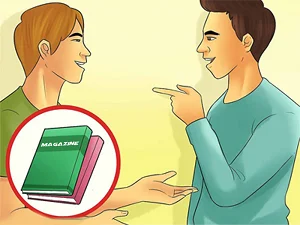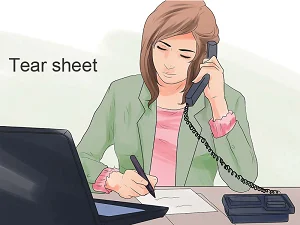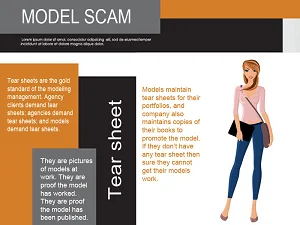The Risks and Realities in Modeling Scams
Tear sheets are the gold standard of modeling portfolios. Agencies, clients, and models highly value tear sheets—pages or photographs cut from magazines that highlight models at work. These sheets serve as evidence that the model has been actively working and featured in publications, underscoring their significance. To acquire these valuable assets, new models often venture to foreign countries, where obtaining tear sheets can substantially boost their chances of securing work back in their home country.
In the modeling industry, a "tearsheet" typically refers to a physical or digital page that displays an example of a model's work as it appeared in a publication, such as a magazine or catalog. Legitimate tearsheets serve as tangible proof of a model's experience and the success of their past collaborations. However, in the context of modeling scams, the term "tearsheet" can be manipulated and misused by scammers.
Legitimate tearsheets are valuable assets for models and photographers, showcasing their work and providing evidence of their presence in reputable publications. These tearsheets can be included in portfolios and serve as a testament to the model's professional achievements.
In scams, the term "tearsheet" may be misused or misrepresented by individuals or agencies to deceive aspiring models. Scammers may claim that paying certain fees will result in the creation of tearsheets or the inclusion of models in fictitious publications.
Aspiring models should take tear sheets seriously, as they serve as the primary proof considered by agencies when representing a model. Just as clients demand to see tear sheets, agencies also require them. Aspiring models can inquire about tear sheets at a modeling agency's office and check for them on the agency's website.
Tear sheets act as evidence that an agency can successfully secure print work for its models. If an agency has models featured in magazines, etc., they will possess tear sheets as tangible proof of job placements.
Models keep tear sheets in their portfolios, and agencies maintain copies in their books to showcase the models they represent. Lack of tear sheets can be indicative of an agency's inability to secure work for its models.
Unscrupulous model or talent agencies may make grand promises of securing high-end work for their signed models, but without tear sheets, these claims lack substantiation.
Scam modeling companies may pledge magazine and catalog jobs for their models, but these opportunities often result in minimal or no payment for the models.
Tear sheets hold immense significance in modeling agencies. Don't solely rely on verbal assurances; instead, seek published pictures as evidence. While others may make false promises and claims, it's considerably more challenging to fabricate a tear sheet. Always consider a picture in a tear sheet as invaluable, similar to presenting a copy of a check received by models from reputable agencies.
Scammers may promise aspiring models tearsheets in high-profile magazines or publications, creating a sense of prestige and legitimacy. However, these promises may be entirely fabricated, with no real intention of featuring the model's work in any publication.
A common element in tearsheet scams involves the request for upfront fees from models. Scammers may claim that these fees cover the production costs for tearsheets, photo shoots, or other services. Legitimate tearsheets, however, are typically a result of successful modeling projects and collaborations, not fees paid by models.
Scammers may provide aspiring models with tearsheets that lack verifiable information about the publications or clients involved. Legitimate tearsheets include details about the publication, issue date, and other relevant information that can be independently verified.
In the modeling industry, tear sheets refer to printed copies of a model's work that have been published in magazines, catalogs, or other print media. These sheets are essentially pages torn or cut from the publication, showcasing the model's photos or editorial spreads. Tear sheets are an important part of a model's portfolio and serve as tangible evidence of their experience and success in the industry.
Here are some key points about tear sheets in modeling:
- Portfolio Enhancement:
- Professional Validation:
- Building a Portfolio:
- Marketing Tool:
- Agency Representation:
- Online Presence:
Tear sheets are often considered more valuable than digital images alone because they provide physical evidence of a model's published work. Including tear sheets in a portfolio can enhance its overall presentation.
Being featured in reputable publications lends credibility to a model's career. Tear sheets from well-known magazines or campaigns can serve as a form of professional validation.
Models typically collect tear sheets to build a comprehensive portfolio. A portfolio is a compilation of a model's best work, showcasing their versatility, range, and experience. Having a diverse collection of tear sheets demonstrates a model's ability to work in various styles and with different photographers and brands.
Tear sheets can be used as a marketing tool when seeking new opportunities. When approaching agencies or potential clients, models can present their tear sheets as evidence of their marketability and success in the industry.
Agencies often use tear sheets to promote their models to clients and industry professionals. Models signed with agencies may find that their tear sheets are actively used in marketing efforts to secure more work.
In the digital age, tear sheets may also be presented in digital formats on a model's website or social media profiles. This allows for easy access and sharing of their work with a wider audience.
It's important for models to keep track of their tear sheets and update their portfolios regularly. As the modeling industry evolves, a strong portfolio that includes tear sheets can help models stand out and advance their careers.





